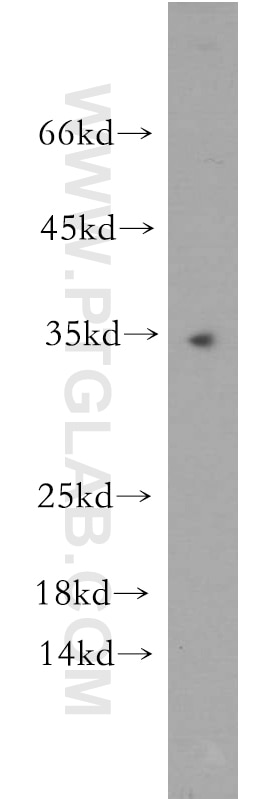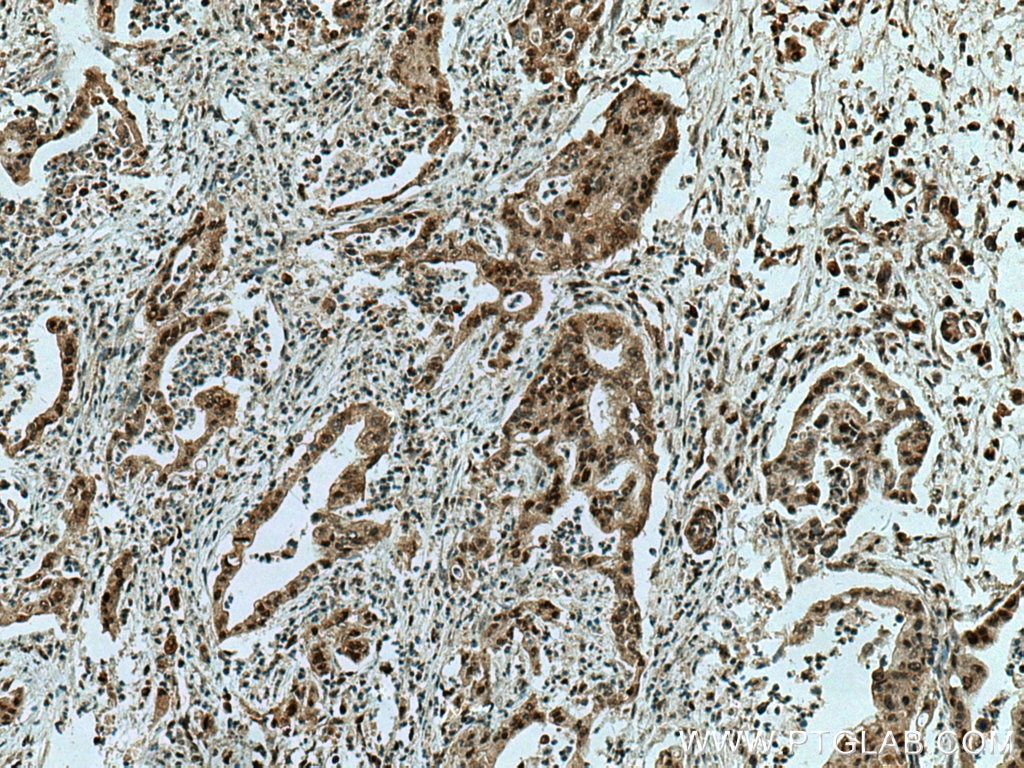Tested Applications
| Positive WB detected in | human testis tissue |
| Positive IHC detected in | human pancreas cancer tissue Note: suggested antigen retrieval with TE buffer pH 9.0; (*) Alternatively, antigen retrieval may be performed with citrate buffer pH 6.0 |
Recommended dilution
| Application | Dilution |
|---|---|
| Western Blot (WB) | WB : 1:500-1:1000 |
| Immunohistochemistry (IHC) | IHC : 1:50-1:500 |
| It is recommended that this reagent should be titrated in each testing system to obtain optimal results. | |
| Sample-dependent, Check data in validation data gallery. | |
Published Applications
| KD/KO | See 2 publications below |
| WB | See 7 publications below |
| IHC | See 5 publications below |
| IF | See 2 publications below |
Product Information
11399-1-AP targets NMNAT1 in WB, IHC, IF, ELISA applications and shows reactivity with human samples.
| Tested Reactivity | human |
| Cited Reactivity | human, mouse, rat |
| Host / Isotype | Rabbit / IgG |
| Class | Polyclonal |
| Type | Antibody |
| Immunogen |
CatNo: Ag1944 Product name: Recombinant human NMNAT1 protein Source: e coli.-derived, PGEX-4T Tag: GST Domain: 1-279 aa of BC014943 Sequence: MENSEKTEVVLLACGSFNPITNMHLRLFELAKDYMNGTGRYTVVKGIISPVGDAYKKKGLIPAYHRVIMAELATKNSKWVEVDTWESLQKEWKETLKVLRHHQEKLEASDCDHQQNSPTLERPGRKRKWTETQDSSQKKSLEPKTKAVPKVKLLCGADLLESFAVPNLWKSEDITQIVANYGLICVTRAGNDAQKFIYESDVLWKHRSNIHVVNEWIANDISSTKIRRALRRGQSIRYLVPDLVQEYIEKHNLYSSESEDRNAGVILAPLQRNTAEAKT Predict reactive species |
| Full Name | nicotinamide nucleotide adenylyltransferase 1 |
| Calculated Molecular Weight | 33 kDa |
| Observed Molecular Weight | 28-32 kDa |
| GenBank Accession Number | BC014943 |
| Gene Symbol | NMNAT1 |
| Gene ID (NCBI) | 64802 |
| RRID | AB_10699868 |
| Conjugate | Unconjugated |
| Form | Liquid |
| Purification Method | Antigen affinity purification |
| UNIPROT ID | Q9HAN9 |
| Storage Buffer | PBS with 0.02% sodium azide and 50% glycerol, pH 7.3. |
| Storage Conditions | Store at -20°C. Stable for one year after shipment. Aliquoting is unnecessary for -20oC storage. 20ul sizes contain 0.1% BSA. |
Background Information
NMNAT1 is a member of the nicotinamide-nucleotide adenylyltransferases (NMNATs) which catalyze nicotinamide adenine dinucleotide (NAD) synthesis (PMID: 28445802). NMNAT is a central enzyme in NAD biosynthesis, catalyzing the formation of NAD+ from nicotinamide mononucleotide (NMN) and ATP (PMID: 17402747). NMNAT1 is widely expressed with the highest levels in skeletal muscle, heart, and kidney(PMID: 11027696). Mutations in NMNAT1 have been shown associated with the LCA9 form of the retinal degeneration pathology Leber's congenital amaurosis (PMID: 22842229, 22842230).
Protocols
| Product Specific Protocols | |
|---|---|
| IHC protocol for NMNAT1 antibody 11399-1-AP | Download protocol |
| WB protocol for NMNAT1 antibody 11399-1-AP | Download protocol |
| Standard Protocols | |
|---|---|
| Click here to view our Standard Protocols |
Publications
| Species | Application | Title |
|---|---|---|
J Am Soc Nephrol Pre-emptive Short-term Nicotinamide Mononucleotide Treatment in a Mouse Model of Diabetic Nephropathy. | ||
Metabolism Hyperglycemia-reduced NAD+ biosynthesis impairs corneal epithelial wound healing in diabetic mice. | ||
J Proteome Res Reduced Nicotinamide Mononucleotide (NMNH) Potently Enhances NAD(+) and Suppresses Glycolysis, the TCA Cycle, and Cell Growth | ||
Onco Targets Ther Prognostic and Immunological Significance of NMNAT1 in Colorectal and Pan-Cancer Contexts | ||
Nat Cardiovasc Res Mitochondrial NAD+ deficiency in vascular smooth muscle impairs collagen III turnover to trigger thoracic and abdominal aortic aneurysm | ||
Sci Rep Nicotinamide mononucleotide ameliorates adriamycin-induced renal damage by epigenetically suppressing the NMN/NAD consumers mediated by Twist2 |
Reviews
The reviews below have been submitted by verified Proteintech customers who received an incentive for providing their feedback.
FH Caitlin (Verified Customer) (09-17-2020) | I used this antibody on neuronal cell lysate for Western blotting. The antibody was able to detect the protein of interest in my lysate (NMNAT3).
|








